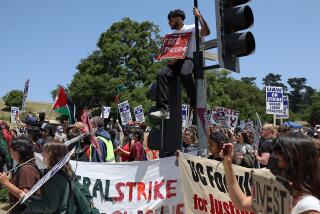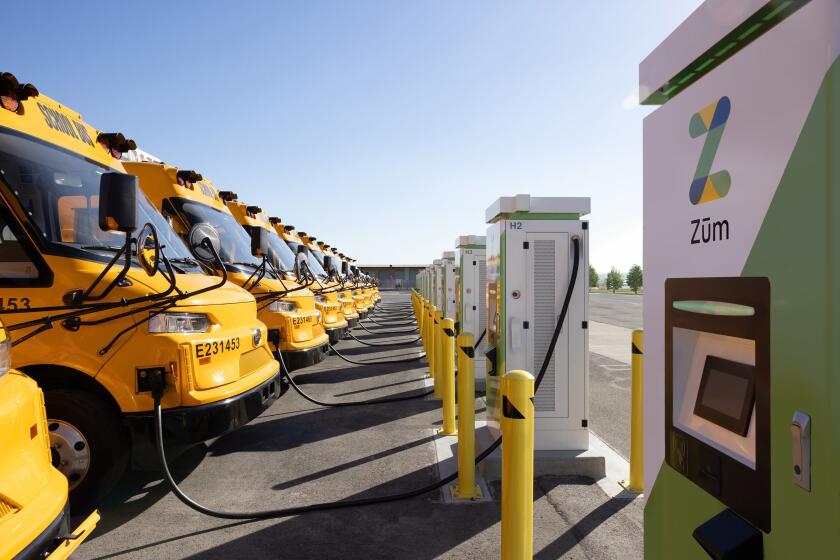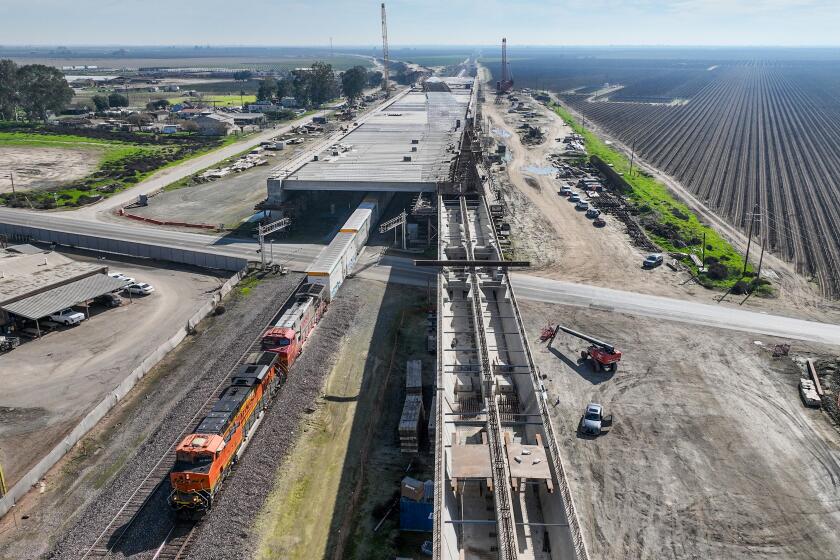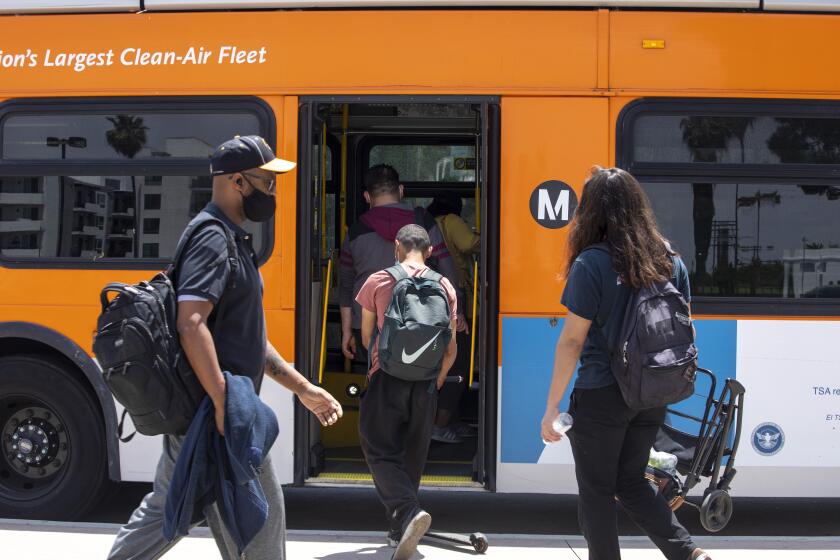Thin Tunnel Walls Found in 2nd Part of Subway System : Transit: Inspector’s memo on Vermont Avenue construction warns about recurrence of problems. Metro Rail officials say repairs have already begun.
Inspectors have discovered that a new stretch of tunnel wall was built thinner than designed on a second major segment of Los Angeles’ $5.8-billion subway system, fueling concerns about the strength of the tunnel.
In a sharply worded memo earlier this month, a private construction inspector questioned why subway work was allowed to progress along Vermont Avenue without determining the cause of the thin concrete in a section of tunnel. He also warned his bosses that they may be repeating the same mistakes that plagued the subway’s first Downtown segment.
“Five months have lapsed since this deficiency was noted and NO corrective actions have taken place,” Parsons-Dillingham inspector Al Hodge said in the June 5 memo, which was obtained by The Times. “Without determining the cause of this problem and taking any required action, we allow the tunnel liner again to be suspect. Have we not learned anything from segment 1?”
Metro Rail officials said that although they have not determined the full extent of the problem, contractors have already repaired one stretch of thin tunnel wall and should be able to easily fix any other defects that are uncovered. Testing will be done next month, they said, to assess whether the walls in the area meet standards.
“I don’t think you can find a housing contractor that can build you a house without the buyer finding a fault with a tile or something,” said Joseph Drew, deputy chief executive at the Metropolitan Transportation Authority. “A problem was identified, and it will be addressed.”
But several engineering experts cautioned that the problem poses a potentially serious threat because a reduction of even a few inches in the walls could make the tunnels more vulnerable to cracking and other structural damage--especially during an earthquake.
“This is deja vu all over again,” said James Pott, a Long Beach engineer who served on the board of the MTA’s rail construction arm. “The causes clearly should be investigated, and corrective action should be taken before charging ahead with the same old practices that give rise to the same old problems.”
The subway construction, designed to relieve gridlock through Downtown and the surrounding areas, has been riddled with problems. Construction and engineering defects spurred the federal government late last year to temporarily cut off $1.6 billion in future subway funding until the MTA could show that it was able to manage the massive project.
Last year, stretches of Hollywood Boulevard above the subway construction sank by up to 10 inches. Last week, half a block of the boulevard collapsed into a sinkhole, which some city and state officials blamed on the subway work. MTA officials have contended that a broken water main triggered the incident.
In 1993, The Times disclosed that segments along the subway’s operational Downtown leg built by Tutor-Saliba Corp. were thinner than designed, spanning as much as 11% of the tunneling along a total of 2.9 miles. MTA officials sought to fix the problem by adding extra reinforcing steel to the suspect area, and they vowed to avoid a recurrence of the problem on the second segment by instituting new construction management safeguards.
But records and interviews show that the issue resurfaced in early January of this year in the Vermont Avenue tunnel built by Shea-Kiewit-Kenny. Workers found a 5-foot-by-5-foot hole or “void” in the concrete tunnel arch between Santa Monica and Beverly boulevards.
On examining the site, contractors realized that a grout pipe had shifted, piercing a heavy plastic tunnel liner designed to keep out gases and water, records show.
Measurements in the immediate area--about a mile south of the site of last week’s Hollywood Boulevard collapse--showed that parts of the wall were only 8.5 inches to 10 inches thick, or as much as 29% below specifications, records show.
Under contract with the MTA, the contractors are paid to build walls that are at least 12 inches thick, or 9 to 10 inches with double reinforcing. There was no double reinforcement in the Vermont Avenue stretch, according to a “nonconformance report” filed by Parsons-Dillingham, the construction manager for the project. A project manager for Shea-Kiewit-Kenny declined to comment and referred all questions to the MTA.
Records show that the initial theory from contractors on the site was that the frames used to set the walls had somehow “floated” or shifted in place before the concrete was poured, effectively reducing the width of the walls by a few inches.
This theory was rejected after early testing. MTA project manager Charles Stark said in an interview that he is convinced that an air pocket was created during the concrete pouring, producing the void in the ceiling and the thin walls around it.
Soon after the problem was discovered in January, contractors went back and fixed the hole and surrounding areas by adding concrete, Stark said.
But officials at the MTA and Parsons-Dillingham say they are still uncertain how extensive the thin wall problem may be because no full-scale testing has been performed.
For the last three months, the area has been sealed off for excavation work on subway stations, preventing the tunnel contractor, Shea-Kiewit-Kenny, from gaining access to the tunnel to perform the tests, officials said.
Records show that the area was not closed off until March--two months after the thin walls were discovered. No extensive testing was done during that time, said one source in the construction operation who spoke on condition of anonymity, because “it wasn’t prioritized. Scheduling [of the tunnel work] was put ahead of that.”
Hodge, the Parsons-Dillingham inspector who criticized the slow response to the problem, refused to discuss the matter.
In his memo to Parsons-Dillingham officials, Hodge estimated that three-quarters of the concrete work on the liner arches along Vermont Avenue was performed after the thin walls were discovered, although it was never determined what had gone wrong. Hodge also emphasized that the cause of the thin concrete should be determined before construction of tunnel arches along Hollywood Boulevard, which began last week.
Drew, the MTA’s deputy chief, said he has been briefed on the issue recently. He expects contractors to do tunnel testing next month to determine the extent of the problem and ensure that the walls are up to standards before they are given final approval.
MTA officials have pointed out that the Downtown subway, where thin walls were discovered in 1993, suffered no damage in the Northridge earthquake last year nor in several smaller ones.
Tests will be crucial in ensuring the stability and longevity of the subway wall along Vermont Avenue, outside experts said.
Although an 8.5-inch wall might be able to support the tunnel, said George N. Housner, a Caltech engineering professor emeritus who has advised the city of Los Angeles on subway issues, “it would be more likely to encourage cracking than if they had a 12-inch wall.”
The potential risk becomes particularly acute during an earthquake, said Pott, the Long Beach engineer, who said MTA officials must be careful to determine whether the problem is isolated or systemic. “It’s just very disappointing to see this happening again,” he said.
More to Read
Start your day right
Sign up for Essential California for news, features and recommendations from the L.A. Times and beyond in your inbox six days a week.
You may occasionally receive promotional content from the Los Angeles Times.






